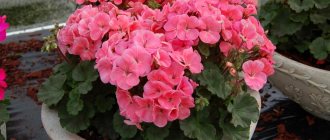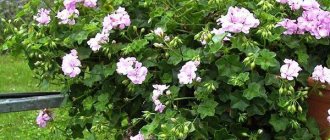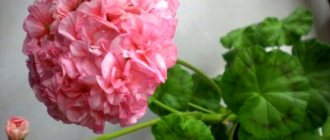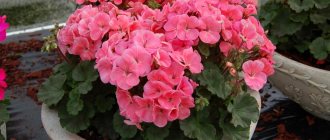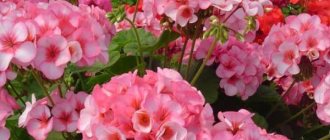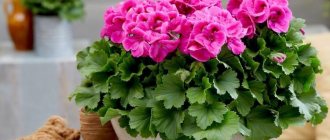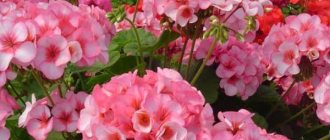Geranium or pelargonium is a common houseplant that feels great outdoors in the summer. In winter, the plant needs a period of rest, which the grower must provide at home.
The plant does not overwinter in open ground; pelargonium can only tolerate light frost; significant cold is destructive for it. Preserving geraniums in an apartment in winter is quite difficult; due to temperature changes outside after autumn, the plant often gets sick and can lose most of its green mass. You can cope with the main problems in growing if preparation for winter in the apartment is ensured, that’s right.
Description of the plant
Geranium belongs to the Geraniaceae genus. Under natural conditions, the plant grows in South Africa. Now the genus has more than 250 species, and new varieties developed by breeders are added to them every year. Their flowering differs in many ways from the usual “ball”; the bushes form on their own and do not stretch out due to lack of light, but ordinary geraniums can also be pruned, ensuring the formation of a beautiful bush.
Plants of this genus can be divided into two groups:
- blooming - valued for their lush flowering, which pleases the gardener almost all year round;
- fragrant - this plant also blooms, but in comparison with previous species it is imperceptible, valued for the aroma exuding from the leaves; they can smell of lemon, mint, spruce and even Coca-Cola.
The root system of the plant is branched. The stem is erect or creeping in some species. The leaves have the appearance of a dissected blade and are covered with small hairs. Flowers are presented in the form of an inflorescence - a brush; it can have more than 40 buds.
The plant blooms all year round provided the temperature conditions, day length and regular application of mineral fertilizers to the soil are provided. After the inflorescence ripens, a fruit-box is formed, which contains small seeds.
Periods of growth and rest
The plant has a short dormant period and enters the dormant phase in December. A new vegetative cycle begins in late February - early March. The dormant period of the plant is characterized by slower growth and lack of flowering. If sufficient daylight is provided, the plant can gain color, but it is recommended to remove the buds because the geranium needs to rest. Lack of rest will not have the best effect on summer flowering - the caps will be less lush. The growth period begins in March and lasts until the end of September. At this time, the plant needs to be fed with fertilizer with a moderate content of nitrogen and phosphates.
You may be interested in:
When to plant marigolds when growing from seeds Many people know what marigold flowers look like. These are positive orange buds with a pleasant smell. Marigolds can…Read more…
To form a beautiful crown and maximum splendor, it is recommended to pinch the flower during the growth period. It is better to do this after flowering, then after pruning the flower will again delight the owner with thick greenery and massive flowering. It is recommended to simply pinch zonal pelargonium for better branching. Ivy-leaved or ampelous geraniums need to be pruned on each branch after the formation of the seventh leaf.
Feeding frequency
It is worth feeding geraniums at home more often than those plants that grow in an open-air flower bed. Indoor pelargoniums should be fertilized 2-3 months after planting, because the soil is completely depleted during this time. It is worth noting that each flowering period is stressful for the flower. It is during this period that it needs additional fertilizers. Fertilizing with urea allows you to saturate the soil with nitrogen, but this option is not used for pelargonium; it is suitable for roses.
Regular feeding is indispensable for a plant that is not growing well. With their help, pelargonium will actively grow and delight others with luxurious blooms.
For information on how to feed geranium at home, watch the following video:
- Author: Maria Sukhorukikh
Rate this article:
- 5
- 4
- 3
- 2
- 1
(0 votes, average: 0 out of 5)
Share with your friends!
Care for geraniums at home
Geranium is a light-loving plant that feels great on an eastern or southern windowsill. Its leaves are delicate, so it is necessary to provide shading from the hot, midday sun, otherwise the foliage will begin to turn yellow and crumble.
Important!
If there is a lack of sunlight, it is better to organize additional illumination with a phytolamp. If there is not enough light, the shoots will stretch out, the leaves will become shredded, and you won’t have to wait for flowering.
If the bush is formed incorrectly, it can be corrected by extending daylight hours. The result will be noticeable in the first month, the shoots will become smoother and thicker. If geranium is kept in a room in winter, it needs to be kept cool - the optimal room temperature is 12-16 degrees. The plant responds well to fresh air, so the room needs to be ventilated, heating radiators dry the air, so it is better to purchase a humidifier.
Temperature and lighting in summer and winter
Plants need a break from summer flowering in order to re-decorate the front garden with bright caps next year. The optimal temperature in summer when kept indoors is 22-26 degrees; for winter it is recommended to lower it to 12-18. A flowerpot with geraniums must be protected from drafts at any time of the year, because the plant has a fragile root system.
Kalachik is demanding on the length of daylight hours and lighting. Without sunny color, the plant stretches out and loses its decorative qualities, the stem partially sheds its leaves and becomes bare. In summer, geranium can be kept in the garden by placing the pot outside or even planting the plant from the pot into open ground. It should be placed in a partially shaded area. The flower needs the soft rays of the morning sun, but the midday heat can destroy it.
How often to water in an apartment
It is impossible to say that pelargonium is a moisture-loving plant; it does not tolerate flooding, therefore excessive soil moisture is destructive for it. It needs to be watered at home after the earthen clod has partially dried out; the plant tolerates temporary drought better than flooding. In winter, the plant is watered once every 10-14 days, and in summer - once every 2-5 days.
Choosing a substrate and fertilizing: how to fertilize correctly
When maintaining a plant, you need to remember that it needs proper care at home and an annual transplant, which involves a complete replacement of the earthen clod. You can plant the plant in any nutrient mixture with the addition of perlite and vermiculite. A sufficient layer of drainage should be placed at the bottom of the flowerpot. The plant loves spacious flowerpots and grows quickly in them, but for rapid flowering, the size of the pot must correspond to the root system. Planting in a large pot will cause the plant to build up its underground root mass, forgetting about flowering.
It grows quickly if the soil is regularly fertilized from the beginning of March to the end of September. For lush flowering, compositions with a high potassium content are used, which should be used 2 times a month in the volumes regulated by the instructions. If a fertilizer is classified as complex, you need to pay attention to the nitrogen content in it, because high doses of the component will lead to a rapid increase in green mass and failure to flower.
Trimming
Pruning is one of the difficult stages in caring for any plant, but flower growers who want to get a neat geranium bush and enjoy its flowering cannot do without such manipulation.
The growth rate depends on the variety and quality of pruning. As they develop, the stems always stretch out and become bare. In this case, the top of the stem is cut off and re-rooted, and the remaining bare stem with roots can be tried to be revived. The pot needs to be provided with complete care and good lighting, then young rudiments of future branches will appear on the bare stump.
To prevent the formation of a bare stem, it is recommended to prune the plant every year after the completion of the vegetative cycle. The plant is cut as much as possible to awaken dormant buds. Since geranium does not stop growing completely, it becomes necessary to re-form after increasing daylight hours - in March.
Attention!
Formation allows you to obtain a mass of planting material. Cuttings obtained in spring or autumn, with proper care and successful rooting, will bloom next summer. This method of propagation is better than sowing seeds - all plants will have the varietal characteristics of the parent. When propagating by seed, there is a risk of cross-pollination.
Preparation for wintering: winter storage
In autumn, the plant is pruned as much as possible, leaving no more than 7 leaves on the stem. Be sure to remove the stepsons growing from the lateral axils, because they will suck out from the mother plant all the nutrients necessary for successful wintering. To get abundant flowering, wintering pelargoniums should be cool; you can save the plants on a windowsill or in the basement.
The process of preparing for wintering includes reducing watering, eliminating fertilizing with various fertilizers, and pruning with the obligatory removal of flower stalks.
When storing in the basement, you need to take into account that each plant is cut and removed from the ground, placed in an airtight container, which will have to be ventilated at least once every 2 weeks. The storage basement must be dry, the temperature in it should not fall below 10 degrees - otherwise the plant will die.
You may be interested in:
How to care for the Decembrist flower? Decembrist is a beautiful and amazing flower that blooms in frosty winters. Therefore, if you want to do...Read more...
How to welcome spring
Closer to spring, when the temperature outside reaches 2 degrees above zero, you can take pots of pelargonium to the balcony. You need to start with half an hour, gradually increasing the time the geranium stays on the balcony. In this way you can help pelargonium bloom constantly.
- If the geranium was stored in the basement, then before taking it outside, you need to soak the bunches in water with fertilizer, then plant them in a pot.
- Geraniums in a pot should stay indoors for about a week. Only after the last frost has occurred is pelargonium planted in the garden flower garden.
Thus, geraniums should be placed in a cool room in winter, provided with additional lighting and monitored soil moisture. You also need to break off dried leaves and flower stalks from time to time. If you follow all these simple rules, pelargonium will delight you with its flowering and aroma immediately after leaving the resting phase.
Inspect the plants every month to see if they are becoming too dry and shriveled. Spray hanging plants with water if necessary. If the geraniums become so dry that the stems begin to shrivel, remove them from the bags and soak the roots for an hour or two in cool water. After soaking in water, allow them to dry before storing them in paper bags. Do this several times throughout the winter to keep the plants from drying out. Plants that have been overwintered may take several weeks to begin growing again in the spring.
Wintering sites for pelargoniums
The following conditions are suitable for wintering:
- glazed balcony or loggia, provided that the temperature does not drop below 8-10 degrees;
- window sill at a room temperature of no more than 17 degrees;
- cellar or basement - plants in flowerpots are placed in the most illuminated place; if it is impossible to provide natural light, the method is not used;
- refrigerator - without soil and roots, leaving only the above-ground part in the form of a stem, you need to regularly check the condition of the plant.
In order for adult plants to successfully overwinter, they must retire healthy. At the end of August, plants planted in open ground should be inspected for pests.
Control
Preparing geraniums for the arrival of winter begins with regular monitoring of the plant. All of them must be healthy, free from disease, mold and pests. It is better to treat your plants preventatively with chemicals than to overlook aphids, which can make a big mess for you. During wet and cold autumn weather, several diseases appear, most notably geranium rust, as well as pests.
Reproduction and transplantation
To propagate the ball, 2 methods are used: cuttings and sowing seeds. The first method has one drawback - it is important to select suitable seed material. Cuttings affected by pests or diseases will not be able to take root. With the seed method, the difficulty lies in caring for the planting. It is important not to overwater young plants and to ventilate the organized greenhouse in a timely manner.
Seeds: how to care
Kalachik reproduces well with the help of seeds; you can collect them yourself from a flowering bush or purchase them in a store. Store-bought seeds need to be checked by expiration date; if they are collected recently, germination rate will be high.
The seeds are planted in loose soil, slightly moistened and previously disinfected with a solution of potassium manganese, and planted to a depth of 2 cm. The pot with fresh seeds is covered with glass or plastic film and kept at a temperature of 18-22 degrees. The glass is removed after germination. The sprout is pinched after the formation of 5 leaves. Spray with a spray bottle, being careful not to touch the seedlings.
Interesting to know!
A plant grown from seeds can bloom in 6 months, so it is better to sow it in February.
They are transplanted into a separate pot after the formation of large bushes with 2-4 pairs of true leaves.
Growing by cuttings
Growing a full-fledged plant from a cutting is quite simple. To do this, use the remains after autumn or spring pruning. It is better to choose cuttings with a lignified trunk. There are several popular rooting methods:
- Water. Add an activated carbon tablet to a small container of water and place the cutting in it. Place the glass on a well-lit windowsill and wait for the roots. The process of their appearance in the spring takes about a week, and in the fall more than a month. The main risk when using this method is rot.
- Perlite or vermiculite. The cuttings are rooted in moistened perlite or vermiculite, placing the sprout at a slight angle - this way the young plant will spend less energy on its own support. The plant is placed in a consecrated place or under a phytolamp.
- Peat. It is convenient to use a peat tablet. It needs to be soaked in water before use. After opening it to the volume of the glass, a stalk with an oblique cut is placed in the center. The advantage of this method is the ability to subsequently transship instead of transplanting. This method has the advantage that the peat in tablets is disinfected, therefore the risk of death of the cutting is minimal.
- Priming. The plant takes root in the soil, as in a peat tablet, only the substrate must first be prepared. It is coughed out in the oven or doused with manganese to disinfect it.
The cuttings are transplanted into a permanent pot after noticeable growth and the formation of new leaves. It is better to wait until the roots have entwined the entire existing earthen ball.
Landing
The plant must be replanted carefully due to the fact that its root system is delicate. The new flowerpot should be two centimeters larger in diameter than the previous one. It is not worth using a large pot, because the plant will not bloom. It is recommended to plant geraniums rooted from cuttings or a bush after wintering in April - during the period of growth and development.
Transfer
Before replanting, the ball needs to be watered with water. So, it will be easier to remove the earth ball from the flowerpot. Transplantation is carried out in spring or autumn, after flowering has ended. After transplanting into new soil, the plant is not fed with fertilizers for 4 months. The substrate contains all the nutrients necessary for growth and development.
How to feed geranium with folk remedies to bloom profusely
For successful flowering, it is necessary to maintain a balance of basic nutrients: nitrogen, phosphorus, potassium. As mentioned earlier, the dose of nitrogen is minimal and should be applied in the spring to stimulate growth. Also periodically water with iodine water.
The presence of the following components in the soil is important: zinc, magnesium, copper, manganese, iron, phosphorus, boron. According to the advice of experienced gardeners, calcium supplementation will be required.
You can feed with complex mineral fertilizers, but there are simple ways to prepare fertilizers yourself. In the first case, you have to spend money on buying fertilizers, but you don’t have to bother with preparation. The second option is budget-friendly; fertilizers are prepared literally from available materials. Let's look at a few recipes.
How to feed geraniums with iodine for abundant flowering
A very simple but effective method to make geraniums bloom profusely is to feed them with iodine. It couldn't be simpler to think of:
- For 1 liter of water you need 2 drops of iodine.
- First you need to water it with plain water, and then pour a little iodine solution (about a quarter of a glass) along the edge of the pot.
- We feed once every two weeks.
As soon as the geranium has bloomed and stopped throwing out flower stalks, feel free to start feeding it with iodine. This fertilizer can be used even in winter. For more information on how to feed geraniums with iodine, watch the video:
How to feed geranium with yeast
Yeast feeding is an excellent growth stimulator. When introduced into the soil, yeasts promote the production of nitrogen and potassium. It is especially good after transplanting and cutting geraniums: the fertilizer is absolutely safe and does not burn damaged roots and stems.
Here's how to feed geraniums with yeast:
- For 1 liter of warm water you will need 20 grams of dry yeast (1 sachet), let the mixture stand for 2-3 hours in a warm place and dilute with another 5 liters of water.
- You will need to water the flower with this fertilizer 2-3 times every 7-10 days.
You can feed geranium with yeast and sugar:
- For 1 liter of warm water, take 10 grams of dry yeast (half a bag) and 1 tablespoon of sugar. Let the mixture ferment for 2 hours, add another 5 liters of water and feed the flowers.
You understand that yeast dressing must be prepared fresh every time, it cannot be stored.
How to feed geraniums to prevent leaves from turning yellow
If the plant looks depressed or is weakened by disease, spray with a solution of hydrogen peroxide. Buy 3% hydrogen peroxide and dissolve 2 tablespoons in 1 liter of water. Then spray the leaves or water the flowers.
Feeding with milk
It is useful to alternate watering with regular water and watering with a milk solution, which is a preventive measure against diseases. Use 100 ml of milk per liter of water, stir and water.
Glucose feeding
Fertilizing with glucose helps to accelerate growth. Dissolve 1 glucose tablet in 1 liter of water and water the flowers. Please note that glucose solution is not suitable for all plants; for example, royal geranium categorically does not tolerate it. If you notice wilting and yellowing of the leaves, this feeding should be stopped.
Possible problems
When growing geraniums at home, gardeners face the following problems:
- leaves turn yellow;
- pests attack;
- leaves fall;
- the stem turns black or rots;
- spots appear on the leaves.
The appearance of these symptoms in any case indicates a pest attack or improper care.
Why do indoor geraniums die?
The main reasons for the death of an indoor flower:
- unregulated watering;
- excessive dry air;
- high room temperature;
- exposure to sunlight;
- damage to the root system during transplantation.
There are many reasons; to find out the true reason, you need to carefully think about what changes the flower has suffered. Often the problem is solved by changing the soil.
Diseases and pests: how to keep a ball
Geranium is rarely attacked by pests, so most often the plant dies when the owner does not follow the basic rules. The death of old leaves located at the bottom of the stem is a natural process. You need to look for the cause if the young buds wither or fall off, and rust forms on the back side.
- If the edges of the leaves turn yellow, you need to increase watering.
- Loss of turgor indicates excess moisture.
- Leaf fall - lack of sunlight.
Important!
“Black leg” is a common problem from which there is no escape for pelargoniums. The only way to preserve the variety is to quickly re-root the apical cutting. After planting, the pot must be treated with a fungicide, and the soil must be thrown away.
How to feed geraniums if the leaves turn yellow
Yellowing of geranium leaves occurs for a number of reasons:
- The root system has grown and the pot has become too small for the flower. In this case, transplant into a larger container and replace the substrate with a new one and the problem will disappear.
- Geranium leaves turn yellow due to improper care: from waterlogging of the soil, very high air temperatures in the autumn-winter period, and drafts.
- If there is no drainage in the pot, the leaves will turn yellow or discolored.
- One of the most common causes of yellowing leaves is excess nitrogen in the soil. Feeding with a potassium-phosphorus composition will help neutralize the problem.
Medicinal properties and benefits of the flower
The leaves of zonal pelargonium release essential oils into the air and destroy viruses and bacteria floating in the room. The plant is recommended to be kept in the children's room because it calms and improves sleep. The leaves of the plant are used for otitis, rhinitis and rheumatism. An infusion is made from them to treat diseases of the gums and throat.
According to popular belief, the flowering of red geranium in an apartment indicates love and mutual understanding in the family. The plant normalizes the aura and makes the psycho-emotional environment more comfortable for life.
Fixed assets
When choosing fertilizers for feeding geranium, you should be very careful, since this plant suffers from organic matter. It is worth choosing mineral supplements. You should go to a specialized store that has a wide range of fertilizers. Although sometimes there are universal remedies that are suitable for all flowering plants. Before purchasing, you should carefully read the composition of the drug so as not to harm the plant.
Fertilizer for geraniums should include the following components:
Gardeners use various additives, which can be roughly divided into several groups.
Ready
In modern stores you can find many options for feeding geraniums, including dry ones. If you need to fertilize in the spring, the preparations should also include nitrogen. With its help, geranium will quickly increase its green mass and have time to prepare for flowering.

